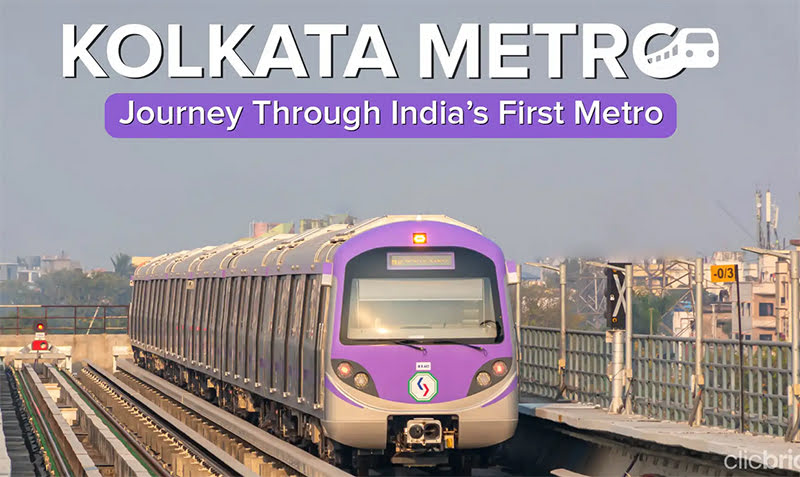Kolkata Metro is a rapid transit system that currently serves Kolkata but is intended to eventually connect Howrah, the twin city. The framework has 3 lines under activity, 3 are under development, while 3 more have been arranged. The system currently makes use of 1,676 mm (broad gauge) tracks, and the 750 V DC electricity comes from a third rail. Trains with four or eight coaches travel on elevated viaducts, underground, and the ground. The trains have a maximum speed of 80 kilometers per hour and run every 5 to 20 minutes.
Kolkata Metro Route Map
When the metro rail urban mass rapid transit system began operating in 1984, Kolkata became the first city in India to do so. The Kolkata Metro network currently consists of two operational lines with a combined length of approximately 38 kilometers. With the assistance of cutting-edge technology and brand-new infrastructure, Kolkata’s metro rail system has undergone significant enhancements over the years. In order to improve the city’s connectivity, Kolkata became the first city in India to have an underwater metro tunnel constructed. On March 15, 2024, services on the underwater metro line were made available to the general public.
Check Also:-
History Of Kolkata Metro
During a meeting of the British Legislative Council in Shimla in September 1919, discussions about building a railway line in Kolkata began. a group led by W. E. Crum was established to investigate this project. The proposed metro line was planned to interface Bagmari in the east to Benaras Street in the west, with a passage under the Hooghly Waterway. The fare for this 10.4-kilometer line was set at three annas, or 0.1875 rupees. Additionally, Harley Dalrymple-Hay proposed a north-south corridor in 1921. Be that as it may, the two ventures required more subsidizing than the majestic government couaxld give, and subsequently, they were not sought after.
Kolkata Metro Lesser-Known Facts
- India’s oldest metro system.
- India’s sole metro system, designated as “deemed” Zone 17 of the Indian Railways in 2010, lowest prices of any Indian metro system.
- There are ten stations named after prominent Bengali figures.
- Rakes don’t all have air conditioning.
- Kolkata Metro to have India’s most memorable submerged segment from now on.
Kolkata Metro Lines
The Kolkata Metro route’s lines are as follows:
Line No. 1 – Blue Line
- Length:2 km
- Stations:26
- Route:Dakshineswar – Kavi Subhash
Kolkata Metro Line 1 turned into the first current mass travel framework in Quite a while when it opened on October 24, 1984. The trains have eight coaches and run at a maximum speed of 55 km/h with a headway of 5–7 minutes. They use 1676 mm (broad gauge) tracks and 750 V DC from a third rail. It travels through some of the city’s most prominent and popular areas in a north-south direction.
Check Also:-
Station List:
- Kavi Subhash– New Garia Railway Station
- Shahid Khudiram
- Kavi Nazrul
- Gitanjali
- Masterda Surya Sen
- Netaji
- Mahanayak Uttam Kumar
- Rabindra Sarobar– Tollygunge Railway Station
- Kalighat
- Jatin Das Park
- Netaji Bhavan
- Rabindra Sadan
- Maidan
- Park Street
- Esplanade
- Chandni Chowk– Sealdah Railway Station
- Central
- Mahatma Gandhi Road
- Girish Park
- Shobhabazar Sutanuti
- Shyambazaar
- Belgachhia– Kolkata Railway Station
- Dum Dum
- Noapara– Netaji Subhas Chandra Bose International Airport
- Baranagar
- Dakshineswar
Line No. 2 – Green Line
- Length:1 km
- Stations:8
- Route:Salt Lake Sector V – Sealdah
Station List:
- Salt Lake Sector V
- Karunamoyee
- Central Park
- City Centre
- Bengal Chemical
- Salt Lake Stadium
- Phoolbagan
- Sealdah– Sealdah Station
Line No. 3 – Purple Line
- Length:2 km
- Stations:6
- Route:Joka – Taratala
Check Also:-
Station List:
- Diamond Park
- IIM Calcutta
- Joka
- Thakurpukur
- Sakherbazar
- Behala Chowrasta
- Behala Bazaar
- Taratala
- Majerhat
- Mominpur
- Kidderpore
- Victoria
- Park Street– Blue Line
- Esplanade– Blue Line, Green Line
Final Words
The Kolkata Metro is a quick travel framework at present serving Kolkata, with likely arrangements to interface the twin city of Howrah. There are three operational lines, three under construction lines, and three more lines in the planning phase of the system. The trains, which can have four or eight coaches, travel over elevated, underground, and ground-level viaducts. Over 700,000 people use the Kolkata Metro every day. It has a maximum speed of 80 km/h and trains run every 5 to 20 minutes.
